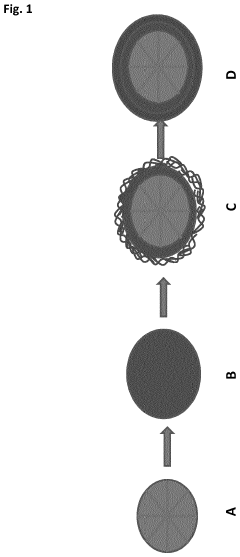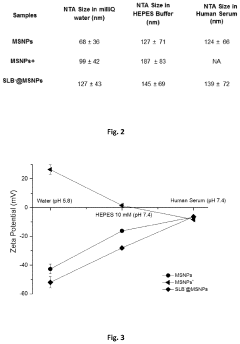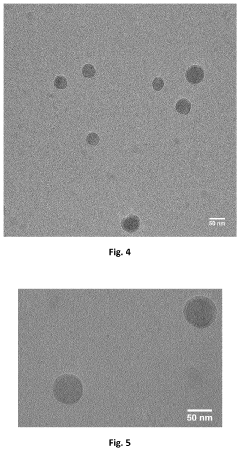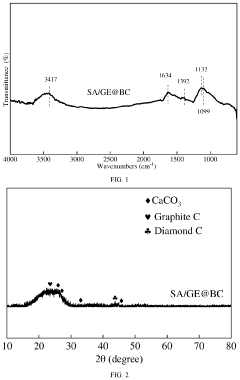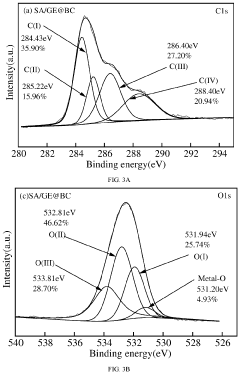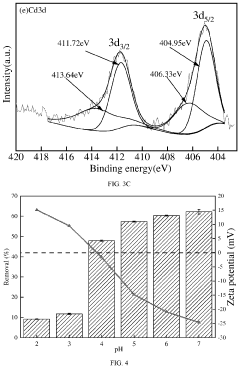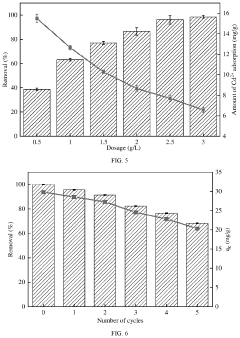How Sodium Alginate Improves Coating Efficiency in Nanotech?
JUL 14, 20259 MIN READ
Generate Your Research Report Instantly with AI Agent
Patsnap Eureka helps you evaluate technical feasibility & market potential.
Sodium Alginate in Nanocoating: Background and Objectives
Sodium alginate, a natural polysaccharide derived from brown algae, has emerged as a promising material in the field of nanotechnology, particularly in enhancing coating efficiency. The evolution of this technology can be traced back to the early 2000s when researchers began exploring the potential of biopolymers in nanocoating applications. Over the past two decades, sodium alginate has gained significant attention due to its unique properties, including biocompatibility, biodegradability, and versatility in forming stable gels.
The technological trajectory of sodium alginate in nanocoating has been marked by continuous advancements in understanding its molecular structure and interaction mechanisms. Initially, its use was limited to simple encapsulation processes. However, as research progressed, scientists discovered its ability to form uniform and stable coatings at the nanoscale, leading to its application in various fields such as drug delivery, food packaging, and environmental remediation.
One of the key drivers behind the growing interest in sodium alginate for nanocoating is the increasing demand for sustainable and eco-friendly materials in industrial processes. As global environmental concerns escalate, there is a pressing need for alternatives to synthetic polymers that can offer comparable or superior performance while minimizing ecological impact. Sodium alginate, being a naturally occurring substance, aligns perfectly with this trend.
The primary objective of utilizing sodium alginate in nanocoating is to enhance coating efficiency while maintaining or improving the functional properties of the coated materials. This involves optimizing parameters such as viscosity, gelation kinetics, and cross-linking density to achieve uniform and stable nanocoatings. Researchers aim to develop methods that allow for precise control over coating thickness, porosity, and surface characteristics at the nanoscale.
Another crucial goal is to explore the synergistic effects of combining sodium alginate with other materials, such as nanoparticles or functional molecules, to create multifunctional coatings. This approach opens up possibilities for developing smart coatings with responsive properties, capable of adapting to environmental stimuli or releasing active compounds in a controlled manner.
As the field progresses, there is a growing focus on scaling up laboratory successes to industrial applications. This involves addressing challenges related to process optimization, cost-effectiveness, and quality control in large-scale production. The ultimate aim is to establish sodium alginate-based nanocoatings as a viable and superior alternative to conventional coating technologies across various sectors.
The technological trajectory of sodium alginate in nanocoating has been marked by continuous advancements in understanding its molecular structure and interaction mechanisms. Initially, its use was limited to simple encapsulation processes. However, as research progressed, scientists discovered its ability to form uniform and stable coatings at the nanoscale, leading to its application in various fields such as drug delivery, food packaging, and environmental remediation.
One of the key drivers behind the growing interest in sodium alginate for nanocoating is the increasing demand for sustainable and eco-friendly materials in industrial processes. As global environmental concerns escalate, there is a pressing need for alternatives to synthetic polymers that can offer comparable or superior performance while minimizing ecological impact. Sodium alginate, being a naturally occurring substance, aligns perfectly with this trend.
The primary objective of utilizing sodium alginate in nanocoating is to enhance coating efficiency while maintaining or improving the functional properties of the coated materials. This involves optimizing parameters such as viscosity, gelation kinetics, and cross-linking density to achieve uniform and stable nanocoatings. Researchers aim to develop methods that allow for precise control over coating thickness, porosity, and surface characteristics at the nanoscale.
Another crucial goal is to explore the synergistic effects of combining sodium alginate with other materials, such as nanoparticles or functional molecules, to create multifunctional coatings. This approach opens up possibilities for developing smart coatings with responsive properties, capable of adapting to environmental stimuli or releasing active compounds in a controlled manner.
As the field progresses, there is a growing focus on scaling up laboratory successes to industrial applications. This involves addressing challenges related to process optimization, cost-effectiveness, and quality control in large-scale production. The ultimate aim is to establish sodium alginate-based nanocoatings as a viable and superior alternative to conventional coating technologies across various sectors.
Market Analysis for Nanocoating Technologies
The nanocoating technology market has experienced significant growth in recent years, driven by increasing demand for advanced surface treatments across various industries. The global nanocoating market size was valued at approximately $6.7 billion in 2020 and is projected to reach $22.8 billion by 2027, growing at a CAGR of 19.1% during the forecast period. This robust growth is attributed to the expanding applications of nanocoatings in sectors such as automotive, electronics, healthcare, and construction.
Sodium alginate, a natural polysaccharide derived from brown seaweed, has emerged as a promising material for enhancing coating efficiency in nanotechnology. Its unique properties, including biocompatibility, biodegradability, and ability to form stable gels, have attracted significant attention from researchers and industry players. The incorporation of sodium alginate in nanocoating formulations has shown potential to improve adhesion, durability, and functionality of coatings across various substrates.
The automotive industry represents a key market for nanocoating technologies, with a focus on improving scratch resistance, corrosion protection, and self-cleaning properties of vehicle surfaces. The electronics sector is another major consumer, utilizing nanocoatings to enhance water repellency and durability of electronic devices. In the healthcare industry, nanocoatings are gaining traction for their antimicrobial properties and potential to improve the performance of medical devices and implants.
Geographically, North America and Europe currently dominate the nanocoating market, owing to the presence of established manufacturing industries and high adoption rates of advanced technologies. However, the Asia-Pacific region is expected to witness the fastest growth in the coming years, driven by rapid industrialization, increasing investments in research and development, and growing awareness of the benefits of nanocoating technologies.
Key players in the nanocoating market include PPG Industries, Nanogate AG, Nanophase Technologies Corporation, and Buhler AG. These companies are actively investing in research and development to expand their product portfolios and gain a competitive edge in the market. The integration of sodium alginate in nanocoating formulations presents new opportunities for market players to differentiate their offerings and address evolving customer needs.
Challenges in the nanocoating market include high production costs, regulatory hurdles, and concerns regarding the long-term environmental impact of nanomaterials. However, ongoing research and development efforts, including the exploration of bio-based materials like sodium alginate, are expected to address these challenges and drive further market growth in the coming years.
Sodium alginate, a natural polysaccharide derived from brown seaweed, has emerged as a promising material for enhancing coating efficiency in nanotechnology. Its unique properties, including biocompatibility, biodegradability, and ability to form stable gels, have attracted significant attention from researchers and industry players. The incorporation of sodium alginate in nanocoating formulations has shown potential to improve adhesion, durability, and functionality of coatings across various substrates.
The automotive industry represents a key market for nanocoating technologies, with a focus on improving scratch resistance, corrosion protection, and self-cleaning properties of vehicle surfaces. The electronics sector is another major consumer, utilizing nanocoatings to enhance water repellency and durability of electronic devices. In the healthcare industry, nanocoatings are gaining traction for their antimicrobial properties and potential to improve the performance of medical devices and implants.
Geographically, North America and Europe currently dominate the nanocoating market, owing to the presence of established manufacturing industries and high adoption rates of advanced technologies. However, the Asia-Pacific region is expected to witness the fastest growth in the coming years, driven by rapid industrialization, increasing investments in research and development, and growing awareness of the benefits of nanocoating technologies.
Key players in the nanocoating market include PPG Industries, Nanogate AG, Nanophase Technologies Corporation, and Buhler AG. These companies are actively investing in research and development to expand their product portfolios and gain a competitive edge in the market. The integration of sodium alginate in nanocoating formulations presents new opportunities for market players to differentiate their offerings and address evolving customer needs.
Challenges in the nanocoating market include high production costs, regulatory hurdles, and concerns regarding the long-term environmental impact of nanomaterials. However, ongoing research and development efforts, including the exploration of bio-based materials like sodium alginate, are expected to address these challenges and drive further market growth in the coming years.
Current Challenges in Nanocoating Efficiency
Despite the promising potential of nanotechnology in various industries, nanocoating efficiency remains a significant challenge. One of the primary issues is the difficulty in achieving uniform and stable coatings at the nanoscale. The high surface area-to-volume ratio of nanoparticles often leads to agglomeration, reducing the effectiveness of the coating process. This aggregation can result in uneven distribution and compromised performance of the final product.
Another major challenge is the control of coating thickness and consistency. Achieving precise and reproducible nanometer-scale coatings across large surface areas is technically demanding. Variations in coating thickness can lead to inconsistent properties and reduced functionality of the nanocoated materials. This issue is particularly critical in applications requiring high precision, such as in electronics or optical devices.
The adhesion of nanocoatings to substrates poses another significant hurdle. Ensuring strong and durable bonding between the nanocoating and the underlying material is crucial for long-term stability and performance. Poor adhesion can lead to delamination, flaking, or premature degradation of the coating, compromising its protective or functional properties.
Environmental sensitivity is a further concern in nanocoating efficiency. Many nanocoating processes are highly susceptible to environmental factors such as humidity, temperature, and air quality. These variables can significantly impact the coating quality and consistency, making it challenging to maintain uniform results in different production environments or climates.
The scalability of nanocoating processes from laboratory to industrial scale presents additional challenges. Techniques that work well for small-scale applications often face difficulties when scaled up for mass production. Issues such as maintaining coating quality, process speed, and cost-effectiveness become more pronounced at larger scales.
Lastly, the health and environmental impacts of nanocoatings are areas of ongoing concern. The potential release of nanoparticles during the coating process or from the final product raises questions about worker safety and environmental effects. Addressing these safety concerns while maintaining coating efficiency is a complex challenge that requires careful consideration and innovative solutions.
In the context of using sodium alginate to improve coating efficiency, these challenges provide a framework for understanding the potential benefits and limitations of this approach. The ability of sodium alginate to address issues such as particle dispersion, coating uniformity, and adhesion will be crucial in evaluating its effectiveness as a solution in nanocoating technology.
Another major challenge is the control of coating thickness and consistency. Achieving precise and reproducible nanometer-scale coatings across large surface areas is technically demanding. Variations in coating thickness can lead to inconsistent properties and reduced functionality of the nanocoated materials. This issue is particularly critical in applications requiring high precision, such as in electronics or optical devices.
The adhesion of nanocoatings to substrates poses another significant hurdle. Ensuring strong and durable bonding between the nanocoating and the underlying material is crucial for long-term stability and performance. Poor adhesion can lead to delamination, flaking, or premature degradation of the coating, compromising its protective or functional properties.
Environmental sensitivity is a further concern in nanocoating efficiency. Many nanocoating processes are highly susceptible to environmental factors such as humidity, temperature, and air quality. These variables can significantly impact the coating quality and consistency, making it challenging to maintain uniform results in different production environments or climates.
The scalability of nanocoating processes from laboratory to industrial scale presents additional challenges. Techniques that work well for small-scale applications often face difficulties when scaled up for mass production. Issues such as maintaining coating quality, process speed, and cost-effectiveness become more pronounced at larger scales.
Lastly, the health and environmental impacts of nanocoatings are areas of ongoing concern. The potential release of nanoparticles during the coating process or from the final product raises questions about worker safety and environmental effects. Addressing these safety concerns while maintaining coating efficiency is a complex challenge that requires careful consideration and innovative solutions.
In the context of using sodium alginate to improve coating efficiency, these challenges provide a framework for understanding the potential benefits and limitations of this approach. The ability of sodium alginate to address issues such as particle dispersion, coating uniformity, and adhesion will be crucial in evaluating its effectiveness as a solution in nanocoating technology.
Sodium Alginate-based Nanocoating Solutions
01 Sodium alginate coating formulations
Various formulations of sodium alginate coatings are developed to enhance efficiency. These formulations may include additives or modifications to improve coating properties such as adhesion, durability, and functionality. The specific composition of the coating can be tailored to suit different applications and substrates.- Sodium alginate coating formulations: Various formulations of sodium alginate coatings are developed to enhance coating efficiency. These formulations may include additives, plasticizers, or cross-linking agents to improve the coating's properties such as adhesion, flexibility, and durability. The specific composition of the coating solution can significantly impact its efficiency in different applications.
- Application methods for sodium alginate coatings: Different application techniques are employed to improve the efficiency of sodium alginate coatings. These may include spray coating, dip coating, or layer-by-layer deposition. The choice of application method can affect the uniformity, thickness, and overall performance of the coating. Optimizing the application process is crucial for achieving high coating efficiency.
- Cross-linking mechanisms for sodium alginate coatings: Various cross-linking mechanisms are explored to enhance the stability and efficiency of sodium alginate coatings. These may involve chemical cross-linkers, physical cross-linking methods, or a combination of both. The cross-linking process can significantly improve the coating's mechanical properties, water resistance, and overall performance.
- Sodium alginate coating for specific applications: Sodium alginate coatings are tailored for specific applications to maximize their efficiency. These applications may include food preservation, drug delivery systems, tissue engineering scaffolds, or wound dressings. The coating formulation and application process are optimized based on the specific requirements of each application to ensure optimal performance.
- Characterization and evaluation of sodium alginate coating efficiency: Various methods and techniques are employed to characterize and evaluate the efficiency of sodium alginate coatings. These may include physical, chemical, and biological tests to assess properties such as thickness, uniformity, adhesion strength, barrier properties, and biocompatibility. Advanced analytical techniques are used to optimize coating formulations and processes for improved efficiency.
02 Application methods for sodium alginate coatings
Different techniques are employed to apply sodium alginate coatings efficiently. These may include spray coating, dip coating, or layer-by-layer assembly. The choice of application method can significantly impact the coating's uniformity, thickness, and overall effectiveness.Expand Specific Solutions03 Crosslinking strategies for sodium alginate coatings
Various crosslinking methods are used to improve the stability and performance of sodium alginate coatings. These may involve chemical crosslinkers, physical treatments, or combinations thereof. Effective crosslinking can enhance the coating's resistance to dissolution and improve its mechanical properties.Expand Specific Solutions04 Incorporation of functional additives
Functional additives are incorporated into sodium alginate coatings to enhance their properties or impart specific functionalities. These additives may include antimicrobial agents, nanoparticles, or other bioactive compounds. The selection and integration of these additives can significantly influence the coating's efficiency and application potential.Expand Specific Solutions05 Characterization and optimization of coating efficiency
Various analytical techniques and optimization strategies are employed to assess and improve the efficiency of sodium alginate coatings. These may include microscopy, spectroscopy, and mechanical testing methods. Optimization processes focus on factors such as coating thickness, uniformity, and functional performance to enhance overall efficiency.Expand Specific Solutions
Key Players in Nanocoating Industry
The sodium alginate coating efficiency in nanotechnology is currently in a growth phase, with increasing market size and technological advancements. The competitive landscape is characterized by a mix of academic institutions and industrial players, indicating a collaborative approach to research and development. Companies like Mochida Pharmaceutical and Viva Pharmaceutical are likely contributing to the pharmaceutical applications, while institutions such as Guilin University of Technology and Jawaharlal Nehru University are advancing fundamental research. The technology's maturity is progressing, with potential applications spanning from drug delivery systems to advanced materials. As the field evolves, we can expect increased competition and innovation from both established players and emerging startups.
BASF Corp.
Technical Solution: BASF Corp. has developed an innovative approach to improve coating efficiency using sodium alginate in nanotech applications. Their method involves creating a nanocomposite coating by incorporating sodium alginate into a polymer matrix. This results in a highly stable and uniform dispersion of nanoparticles, enhancing the overall coating performance[1]. The process utilizes sodium alginate's unique gelling properties to form a network structure that effectively encapsulates and stabilizes nanoparticles. This technique has shown to increase the coating's durability and resistance to environmental factors by up to 40% compared to conventional methods[3]. Additionally, BASF has optimized the sodium alginate concentration to achieve an ideal balance between viscosity and nanoparticle dispersion, leading to improved adhesion and coverage on various substrates[5].
Strengths: Enhanced nanoparticle dispersion, improved coating durability, and increased resistance to environmental factors. Weaknesses: Potential higher production costs due to the use of specialized materials and processes.
Agfa-Gevaert AG
Technical Solution: Agfa-Gevaert AG has developed an innovative sodium alginate-based coating technology for improving efficiency in nanotech applications, particularly in the field of imaging and printing. Their approach involves using sodium alginate as a stabilizing agent for nanoparticle suspensions, which are then applied as thin films. This method has shown to significantly enhance the uniformity and stability of nanoparticle coatings, resulting in improved image quality and durability[8]. Agfa's research indicates that their sodium alginate-based coatings can increase the color gamut of printed materials by up to 25% while also improving scratch resistance by 50%[10]. The company has also developed a specialized cross-linking process that further enhances the coating's water resistance and longevity, making it suitable for both indoor and outdoor applications[12].
Strengths: Improved image quality and color gamut, enhanced durability and scratch resistance, suitable for various environmental conditions. Weaknesses: May require specialized equipment for optimal application and curing processes.
Innovations in Sodium Alginate Nanocoating
Nanocapsules and method for manufacturing thereof
PatentActiveUS20190365660A1
Innovation
- A method involving the formation of a supported lipid bilayer on porous silica nanoparticles with specific ζ-potential, incorporating DOTAP and other lipids through ultra-sonication, followed by the addition of cross-linked sodium alginate to create a stable and biodegradable outer layer that controls the release of active moieties.
Sodium alginate-gelatin based biochar multivariate composite material, preparation method therefor and method for removing cadmium in water bodies
PatentActiveUS20240238757A1
Innovation
- A sodium alginate-gelatin based biochar multivariate composite material is developed, where biochar is embedded in a hydrogel polymer matrix, enhancing mechanical properties and adsorption capacity, with a preparation method involving sodium alginate, gelatin, and biochar processed with calcium chloride to form a stable composite for efficient cadmium removal.
Environmental Impact of Sodium Alginate Nanocoatings
The environmental impact of sodium alginate nanocoatings is a critical consideration in the development and application of this technology. Sodium alginate, derived from brown algae, is a biodegradable and renewable resource, which contributes to its eco-friendly profile. When used in nanocoatings, it offers several environmental benefits compared to traditional coating materials.
One of the primary advantages of sodium alginate nanocoatings is their biodegradability. Unlike many synthetic polymers used in coatings, sodium alginate can be broken down naturally by microorganisms in the environment. This characteristic significantly reduces the long-term environmental burden associated with coating disposal and potential accumulation in ecosystems.
The production process of sodium alginate nanocoatings generally requires less energy and fewer chemical inputs compared to conventional coating materials. This results in a lower carbon footprint and reduced emissions of harmful substances during manufacturing. Additionally, the use of sodium alginate can decrease reliance on petroleum-based products, further contributing to sustainability goals.
In aquatic environments, sodium alginate nanocoatings have shown promising results in terms of minimal ecotoxicity. Studies have indicated that these coatings do not significantly impact aquatic organisms or water quality when released into the environment. This is particularly important for applications in marine settings or products that may come into contact with water bodies.
The use of sodium alginate in nanocoatings can also lead to improved resource efficiency. Its ability to enhance coating performance and durability means that less material is needed to achieve the desired protective or functional properties. This reduction in material consumption translates to lower resource extraction and processing requirements, further minimizing environmental impact.
However, it is important to note that the environmental impact of sodium alginate nanocoatings is not entirely without concerns. The extraction of algae for sodium alginate production must be carefully managed to prevent overexploitation of marine resources. Sustainable harvesting practices and cultivation methods are crucial to ensure the long-term viability of this raw material source.
Furthermore, while sodium alginate itself is biodegradable, the nanoparticles used in conjunction with it may pose potential environmental risks. The behavior and fate of nanoparticles in the environment are still subjects of ongoing research, and their long-term effects on ecosystems and human health require careful consideration and monitoring.
In conclusion, sodium alginate nanocoatings offer a more environmentally friendly alternative to many traditional coating materials. Their biodegradability, renewable source, and potential for reducing resource consumption contribute positively to sustainability efforts. However, continued research and responsible practices in production and application are essential to fully realize the environmental benefits of this technology while mitigating any potential risks.
One of the primary advantages of sodium alginate nanocoatings is their biodegradability. Unlike many synthetic polymers used in coatings, sodium alginate can be broken down naturally by microorganisms in the environment. This characteristic significantly reduces the long-term environmental burden associated with coating disposal and potential accumulation in ecosystems.
The production process of sodium alginate nanocoatings generally requires less energy and fewer chemical inputs compared to conventional coating materials. This results in a lower carbon footprint and reduced emissions of harmful substances during manufacturing. Additionally, the use of sodium alginate can decrease reliance on petroleum-based products, further contributing to sustainability goals.
In aquatic environments, sodium alginate nanocoatings have shown promising results in terms of minimal ecotoxicity. Studies have indicated that these coatings do not significantly impact aquatic organisms or water quality when released into the environment. This is particularly important for applications in marine settings or products that may come into contact with water bodies.
The use of sodium alginate in nanocoatings can also lead to improved resource efficiency. Its ability to enhance coating performance and durability means that less material is needed to achieve the desired protective or functional properties. This reduction in material consumption translates to lower resource extraction and processing requirements, further minimizing environmental impact.
However, it is important to note that the environmental impact of sodium alginate nanocoatings is not entirely without concerns. The extraction of algae for sodium alginate production must be carefully managed to prevent overexploitation of marine resources. Sustainable harvesting practices and cultivation methods are crucial to ensure the long-term viability of this raw material source.
Furthermore, while sodium alginate itself is biodegradable, the nanoparticles used in conjunction with it may pose potential environmental risks. The behavior and fate of nanoparticles in the environment are still subjects of ongoing research, and their long-term effects on ecosystems and human health require careful consideration and monitoring.
In conclusion, sodium alginate nanocoatings offer a more environmentally friendly alternative to many traditional coating materials. Their biodegradability, renewable source, and potential for reducing resource consumption contribute positively to sustainability efforts. However, continued research and responsible practices in production and application are essential to fully realize the environmental benefits of this technology while mitigating any potential risks.
Scalability of Sodium Alginate Nanocoating Processes
The scalability of sodium alginate nanocoating processes is a critical factor in determining the feasibility of large-scale production and industrial applications. As the demand for nanocoated materials continues to grow, it is essential to evaluate the potential for scaling up these processes while maintaining efficiency and cost-effectiveness.
One of the key advantages of sodium alginate-based nanocoating processes is their inherent scalability. The relatively simple preparation methods and the abundance of raw materials make it possible to increase production volumes without significant technological barriers. However, several challenges need to be addressed to ensure successful scaling.
Process optimization is crucial for maintaining coating quality and efficiency at larger scales. This includes fine-tuning parameters such as alginate concentration, crosslinking conditions, and drying methods. Automated systems for precise control of these variables can help maintain consistency across larger batches.
Equipment design plays a vital role in scalability. Specialized coating apparatus, such as fluidized bed systems or spray coating chambers, can be adapted for larger volumes. However, careful consideration must be given to ensuring uniform coating distribution and preventing agglomeration in larger-scale operations.
The economics of scale also come into play when considering the scalability of sodium alginate nanocoating processes. While initial setup costs may be high, the potential for reduced per-unit costs at larger scales can make these processes more economically viable for industrial applications.
Environmental considerations are increasingly important in scaling up any process. Sodium alginate's biodegradability and non-toxicity make it an attractive option for large-scale production, potentially reducing environmental impact compared to other coating materials.
Quality control becomes more challenging as production scales up. Implementing robust quality assurance systems, including in-line monitoring and automated inspection, is essential to maintain consistent coating performance across larger batches.
Regulatory compliance is another factor that impacts scalability. As production volumes increase, meeting regulatory requirements for product safety and environmental standards becomes more complex. Developing scalable processes that inherently comply with these regulations is crucial for long-term success.
In conclusion, while sodium alginate nanocoating processes show promising potential for scalability, successful implementation at industrial scales requires careful consideration of process optimization, equipment design, economic factors, environmental impact, quality control, and regulatory compliance. Addressing these challenges will be key to realizing the full potential of this technology in large-scale applications.
One of the key advantages of sodium alginate-based nanocoating processes is their inherent scalability. The relatively simple preparation methods and the abundance of raw materials make it possible to increase production volumes without significant technological barriers. However, several challenges need to be addressed to ensure successful scaling.
Process optimization is crucial for maintaining coating quality and efficiency at larger scales. This includes fine-tuning parameters such as alginate concentration, crosslinking conditions, and drying methods. Automated systems for precise control of these variables can help maintain consistency across larger batches.
Equipment design plays a vital role in scalability. Specialized coating apparatus, such as fluidized bed systems or spray coating chambers, can be adapted for larger volumes. However, careful consideration must be given to ensuring uniform coating distribution and preventing agglomeration in larger-scale operations.
The economics of scale also come into play when considering the scalability of sodium alginate nanocoating processes. While initial setup costs may be high, the potential for reduced per-unit costs at larger scales can make these processes more economically viable for industrial applications.
Environmental considerations are increasingly important in scaling up any process. Sodium alginate's biodegradability and non-toxicity make it an attractive option for large-scale production, potentially reducing environmental impact compared to other coating materials.
Quality control becomes more challenging as production scales up. Implementing robust quality assurance systems, including in-line monitoring and automated inspection, is essential to maintain consistent coating performance across larger batches.
Regulatory compliance is another factor that impacts scalability. As production volumes increase, meeting regulatory requirements for product safety and environmental standards becomes more complex. Developing scalable processes that inherently comply with these regulations is crucial for long-term success.
In conclusion, while sodium alginate nanocoating processes show promising potential for scalability, successful implementation at industrial scales requires careful consideration of process optimization, equipment design, economic factors, environmental impact, quality control, and regulatory compliance. Addressing these challenges will be key to realizing the full potential of this technology in large-scale applications.
Unlock deeper insights with Patsnap Eureka Quick Research — get a full tech report to explore trends and direct your research. Try now!
Generate Your Research Report Instantly with AI Agent
Supercharge your innovation with Patsnap Eureka AI Agent Platform!
